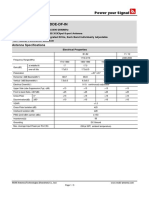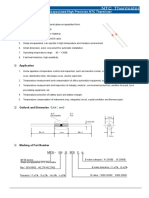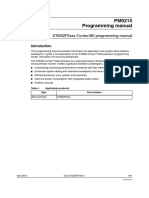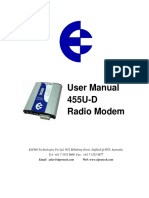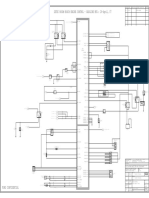Outdoor Lighting
Outdoor Lighting
Uploaded by
Merényi OszkárCopyright:
Available Formats
Outdoor Lighting
Outdoor Lighting
Uploaded by
Merényi OszkárOriginal Description:
Copyright
Available Formats
Share this document
Did you find this document useful?
Is this content inappropriate?
Copyright:
Available Formats
Outdoor Lighting
Outdoor Lighting
Uploaded by
Merényi OszkárCopyright:
Available Formats
OUTDOOR LIGHTING
Basic DIY skills are needed to install new lights and wiring. Connecting things up takes electrical skills and technical knowledge, so if in doubt, employ an electrician.
Always ensure that the power supply is switched off before starting any work on your home's lighting circuits. It is not sufficient to turn off individual light switches. These instructions comply with the requirements of the current IEE wiring regulations.
Adding outdoor lights will show you and your visitors the way to the front door on dark nights, highlight your garden and help to deter intruders. A light by your front door is useful, so that visitors can find it after dark and you can identify them easily. Other lights can be used to illuminate side passages, and paths to the garage and back of the house. All can be wired up as extensions of the house wiring. If you want to install lights some distance from the house, you must use a separate circuit. You can easily install lowvoltage garden lights yourself.
2 - Planning the job
Think about what lighting effect you want to achieve, as this will influence the types of fitting you buy and where you install them.
At the front door, and on the patio, you will probably want a decorative fitting (or two) that looks attractive by day and by night. The style is a matter of personal taste, and there is a wide range to choose from.
Elsewhere, function will be more important than looks. For example, cheap bulkhead fittings are ideal for side paths, garage approaches and so on. The one type of fitting to avoid, unless very high levels of illumination are absolutely essential for security purposes, is the 500-watt floodlight mounted high on your house wall. It is far too powerful for most domestic settings, and its glare merely annoys neighbours and passers-by.
Should you still wish to install floodlights, look for models that help combat light pollution.
Then decide how to provide power for the new lights. The easiest option is to take fused spurs from power circuits, since you can connect the spur into a socket outlet on or near an outside wall and take it straight through the wall to the light position (1). You can connect the spur cable into any socket outlet that is on the main circuit and is not itself supplying a spur in other words, one with two cables present. You cannot connect it to an outlet that is itself a spur, with just one cable supplying it.
If you decide to extend an existing lighting circuit, use the upstairs one which you can access in the loft. You can then drop cables down the outside walls to the light positions. You would have to lift carpets and floorboards to get at the downstairs lighting circuit - a degree of disruption that may not be worth the effort.
Check that extra lights will not overload a lighting circuit. Each can supply a maximum of 1200 watts. A high-wattage floodlight could easily cause an overload and blow fuses.
3 - Choosing fittings
Any light fitting for outdoor use - even in a porch - must be marked as suitable for the purpose.
Inspect fittings before you buy, to see how they are intended to be connected to the circuit wiring. Some have an internal terminal block to which the circuit cable can be wired directly (2).
Others have a flex tail emerging from the fitting; look for ones with a hollow baseplate which can be used to accommodate the wiring connections (3). Both of these fitting types can be mounted straight onto the house wall, with the cable entering via a hole in the wall behind.
Other fittings require mounting over a round rearentry conduit box recessed into the masonry (4) - a job best avoided if possible. Decide how the lights are to be controlled. A porch light can be switched from the hallway, and patio lights from close by the back door. Other lights, with more of a security function, will benefit from passive infra-red (PIR) control, although isolation switches must still be fitted.
A PIR detector senses the movement of any warm object visitor, burglar, animal, car - moving in its field of view, and acts to switch on the lighting it controls. You can buy individual light fittings with an integral PIR detector, or have a separate stand-alone detector linked to a number of ordinary light fittings.
Choose the bulb wattage to suit the situation, bearing in mind the maximum wattage for the fitting. A 40-watt or 60watt bulb will be more than adequate in most situations. Wherever possible, use compact fluorescent lamps rather than tungsten-filament bulbs for long life and economy.
4 - Preparing the cable route
Once you have decided where each light fitting is to be installed, the next step is to create a route for the spur cable. Ideally the cable should emerge immediately behind the fitting's baseplate, but if this isn't possible, the cable can run up or down the outside wall of the house.
When using tools, ensure the relevant safety equipment is used.
Check walls for buried cables and pipes before drilling. Special detectors are available to assist with this.
Use a 16mm diameter masonry drill bit to make a hole for each cable. It must be long enough - 400mm (16in) at least - to penetrate the wall in one go. Work from the outside so you can drill through a soft mortar joint rather than through the face of the bricks, and angle the drill bit very slightly upwards so rainwater will not penetrate the hole.
If you need a recessed conduit box to contain the connections to the light fitting, chop out its recess next. First remove a knockout and hold the box over the drilled hole. Mark its outline on the wall and drill a series of closelyspaced holes within it to a little more than the box depth. Then chop out the honeycombed brick with a cold chisel, clean up the hole and secure the box in the hole with screws and wallplugs.
Slide a length of 16mm PVC conduit through the hole to line it so the cable cannot chafe on the masonry. Then feed in the 1mm2 cable, leaving about 150mm on the outside ready for connection to the light fitting. Indoors, route the cable to near the point you have chosen for the connection to the indoor power circuit. You can clip it to the top of skirting boards, or run it in mini-trunking if you prefer to conceal it.
5 - Installing the light fitting
At the light position, strip the cable sheath and the core insulation and connect the cable to the light fitting. If it has a terminal block (see illustration (2) in the section 'Choosing fittings'), you will probably need to feed the cable through a flexible waterproof seal at the cable entry point. Connect the cores to their terminals, which are generally marked L (live), N (neutral) and E (earth).
If the fitting has a flex tail, link this to the circuit cable, using three strip connectors. Link the cable red core to the flex brown core, the cable black core to the flex blue core and the cable earth core (covered in green/ yellow PVC sleeving) to the flex earth core, if it has one (see illustration (3) in the section 'Choosing fittings'). If it doesn't, simply link the cable earth core to the third strip connector.
If the fitting has a hollow baseplate, fold the cable neatly into it so it contains the strip connectors within it. Then fill the baseplate with clear silicone mastic to waterproof the connections. Use the same technique if the strip connectors are housed in a recessed conduit box.
You can now fix the fitting to the house wall. In most cases,
this involves marking the screw-fixing positions on the wall, drilling holes, inserting wallplugs and holding the fitting in place while you drive in the screws.
Some outside light fittings have a separate baseplate which you screw to the wall. The body of the fitting is then attached to the baseplate with machine screws.
With the fitting securely in place, run a bead of clear silicone mastic all round it to waterproof the junction between fitting and wall.
6 - Making the wiring connection
A spur to a light on the house wall must be fused, so the spur cable is run via a switched fused connection unit (FCU). This also allows the light toMnso t
hM hnru292 03927 41r 000293.58278 635.48029 Tm(n a b)T218.52 0 0 8.52 60258 61(ru)Tj8.52 0 4117 0 Tm7.468.9005.48029 Tm(n a b)T228.52 305.86623 624.26035 Tm(een f)Tj8.52 0 0 8.52 327.357 Tm209.168.52 0.8033 Tm(h)Tj8.52j684017 00293.582Run a.36618 586.82031 T.</M7576984017 00293.582 sh8 scnBT/TT0 1 Tf58209501 4017 00293.58252 90 560.18033 Tm(s2m578684017 00293.582t .5 140.9301 586.820270 9255984017 00293.5820 8.52 331.23636 5607(g03 0 4017 00293.582 120.56125 571.4002.81.43187 4017 00293.582g120.56125 571.4002.8(g)407484017 00293.582t128.91356 560.18033 8.598 is4017 00293.582 128.91356 560.18033 5.492684017 00293.5825This)Tj8.52 0 0 8. 82 950is4017 00293.5828 scnBT/TT0 1 Tf00352064984017 00293.582f scnBT/TT0 1 Tf00652064484017 00293.5825This)Tj8.52 0 0 830.527177 4017 00293.5822.9007 Tm7.1816214 5071.40027 Tm(must)Tj235 92 86 3 8.5Tj5j0 0 cab120.56125 571.4002730.85(s2 3 8.5Tj5j0 0 .5 140.9301 586.8202S351887483 8.5Tj5j0 0 e f.36618 586.82031 T.<1 1202383 8.5Tj5j0 0 52 90 560.18033 Tm(4758620883 8.5Tj5j0 0 8.52 128.91356 560.180337350651983 8.5Tj5j0 0 e FC( )TjETEMC /P 2910
Connect the cable to the output terminals of the transformer (8). Plug the transformer into a switched socket outlet, which will also act as the lights' on-off switch. If the transformer is in an outbuilding or a weatherproof enclosure, the socket outlet supplying it must be protected by a high-sensitivity (30 milliamp) residual current device - the type normally installed for supplying garden power tools.
You might also like
- Denon AVR - 3313 ALL Recv. (Ver. 6) PDFDocument254 pagesDenon AVR - 3313 ALL Recv. (Ver. 6) PDFboroda241067% (3)
- Interior Lighting DesignDocument4 pagesInterior Lighting DesignEvon ChayNo ratings yet
- Black&Decker. ADVANCED HOME WIRING Current With 2012-2015 Codes PDFDocument409 pagesBlack&Decker. ADVANCED HOME WIRING Current With 2012-2015 Codes PDFbandihoot100% (7)
- Module 2V - Light & Lighting FundamentalsDocument6 pagesModule 2V - Light & Lighting Fundamentalsraul_bsu100% (2)
- Licht Hand BuchDocument370 pagesLicht Hand BuchMochammad SholichudinNo ratings yet
- How To Street Lights BusinessDocument32 pagesHow To Street Lights BusinessSandeep Nishikant GupteNo ratings yet
- PRACTICAL GUIDE For Outdoor Lighting PDFDocument21 pagesPRACTICAL GUIDE For Outdoor Lighting PDFDanyitbarekNo ratings yet
- Lecture 7 - Lighting Fundamentals PDFDocument26 pagesLecture 7 - Lighting Fundamentals PDFVictor SaifiNo ratings yet
- 2019 Landscape Lighting Sept 2019Document5 pages2019 Landscape Lighting Sept 2019ALvin SaLvaNo ratings yet
- Recommended Lighting Levels in BuildingsDocument4 pagesRecommended Lighting Levels in BuildingsZahir RamadanNo ratings yet
- Onyx Solar Asi Solutions Brochure SQMDocument4 pagesOnyx Solar Asi Solutions Brochure SQMvarsha2795No ratings yet
- LED Maintenance FactorsDocument6 pagesLED Maintenance FactorsSameer C MusthafaNo ratings yet
- Chapter 6.4 - 6.5Document42 pagesChapter 6.4 - 6.5Roi Vince PiliNo ratings yet
- Illumination Basic and SchemeDocument33 pagesIllumination Basic and Schemegoitom01No ratings yet
- Erco. Lighting For MuseumsDocument9 pagesErco. Lighting For MuseumsjapaNo ratings yet
- Building Services Are The Systems Installed in Buildings To Make Them Comfortable, Functional, EfficientDocument3 pagesBuilding Services Are The Systems Installed in Buildings To Make Them Comfortable, Functional, EfficientRachita Subedi100% (1)
- Led Lighting Is ThornDocument88 pagesLed Lighting Is ThornhansdubarryNo ratings yet
- Artifical Lighting in Convention CenterDocument9 pagesArtifical Lighting in Convention CenterLucasNo ratings yet
- Services LIGHTINGDocument34 pagesServices LIGHTINGAmit Kumar YadavNo ratings yet
- Libres Supermarket ResearchDocument15 pagesLibres Supermarket ResearchPaul Anthony LibresNo ratings yet
- Chapter 2Document40 pagesChapter 2Tariku KebedeNo ratings yet
- Zonal Cavity Method For Calculating The Number of Lamps in An AreaDocument9 pagesZonal Cavity Method For Calculating The Number of Lamps in An AreaAbdulyekini Ahmadu100% (2)
- Street Light: Submitted To:-ArcDocument27 pagesStreet Light: Submitted To:-ArcRatnesh PatelNo ratings yet
- Light Loss Factor CriteriaDocument8 pagesLight Loss Factor CriteriaKo PaukNo ratings yet
- Lighting Design ConsiderationsDocument42 pagesLighting Design Considerationsshivam007No ratings yet
- LED Luminaire Design GuideDocument15 pagesLED Luminaire Design GuideAnonymous SOQFPWBNo ratings yet
- Swimming Pool Lighting DesignDocument2 pagesSwimming Pool Lighting DesignquletjavierNo ratings yet
- 60 Lighting Quiz QuestionsDocument4 pages60 Lighting Quiz Questionsgerald.alegado19No ratings yet
- Illumination AssignmentDocument15 pagesIllumination AssignmentShadowdare VirkNo ratings yet
- Chapter 2Document23 pagesChapter 2Melkamu BirlewNo ratings yet
- Lecture 3 - Natural and Artificial Lighting in Architecture - Ar Intrs 312Document110 pagesLecture 3 - Natural and Artificial Lighting in Architecture - Ar Intrs 312Kia changgiNo ratings yet
- Lighting Handbook Hotel WellnessDocument52 pagesLighting Handbook Hotel Wellnessin678No ratings yet
- Basic Lighting PDFDocument46 pagesBasic Lighting PDFokky_rahmatNo ratings yet
- Evaluating Light OutputDocument12 pagesEvaluating Light OutputDelia Si Gabi BerendeNo ratings yet
- 4 Electric Lighting Design TechniquesDocument34 pages4 Electric Lighting Design TechniquesWaleed Mohammed Fekry100% (1)
- Bldutl2 - Building Utilities 2 Electrical, Electronic and Mechanical SystemsDocument10 pagesBldutl2 - Building Utilities 2 Electrical, Electronic and Mechanical Systemsgimel tenorioNo ratings yet
- Natural and Artificial LightingDocument10 pagesNatural and Artificial LightingRajat GandhiNo ratings yet
- Wood PDFDocument5 pagesWood PDFBenjie LatrizNo ratings yet
- LED Technology Presentation (Rev Kuwait)Document63 pagesLED Technology Presentation (Rev Kuwait)AV Shrinivas100% (3)
- Lumen Method of CalculationDocument12 pagesLumen Method of CalculationsrinivasaphanikiranNo ratings yet
- Lighting Design - Dialux SoftwareDocument19 pagesLighting Design - Dialux SoftwareChanna AshanNo ratings yet
- Artificial LightingDocument37 pagesArtificial LightingArjay Garlan100% (1)
- Conditions Required For Visual ComfortDocument28 pagesConditions Required For Visual ComfortNadia MunifahNo ratings yet
- Facade PresentationDocument67 pagesFacade PresentationEsraa KhairyNo ratings yet
- Lighting CalcsDocument40 pagesLighting CalcsalvinchuanNo ratings yet
- GROUP-9 - 2.8-Lighting Application and Design (REVISED)Document58 pagesGROUP-9 - 2.8-Lighting Application and Design (REVISED)Von ToledoNo ratings yet
- Lighting LibrariesDocument20 pagesLighting LibrariesArch Marwan Al-enabNo ratings yet
- Illumionation ExamDocument4 pagesIllumionation ExamRegie NojaldaNo ratings yet
- Day 4 Presentation PDFDocument30 pagesDay 4 Presentation PDFSarah MaadNo ratings yet
- Calculating The Number of Indoor Lighting FixturesDocument14 pagesCalculating The Number of Indoor Lighting FixturesUMAYAKUMARNo ratings yet
- Coefficient of Utilization (CU) ComputationDocument2 pagesCoefficient of Utilization (CU) ComputationTrisha Elaine H. SantosNo ratings yet
- Facade Guide Low ResDocument42 pagesFacade Guide Low ResfueledbyramenzNo ratings yet
- An Example of Calculating The Number of Indoor Lighting FixturesDocument9 pagesAn Example of Calculating The Number of Indoor Lighting FixturesAbdul RawoofNo ratings yet
- Lighting DesignDocument2 pagesLighting DesignKhay SaadNo ratings yet
- Tennis Court Group 3Document20 pagesTennis Court Group 3bimaNo ratings yet
- Unit 2 IlluminationDocument56 pagesUnit 2 IlluminationsiddharthaNo ratings yet
- SPTC - Instructional Materials - Eim NC IiDocument11 pagesSPTC - Instructional Materials - Eim NC IimariarosalynfloresNo ratings yet
- Lighting Projects Current With 2011 2013 Electrical CodesDocument125 pagesLighting Projects Current With 2011 2013 Electrical Codesdhananjay hawaldarNo ratings yet
- How-To Library: Tools & MaterialsDocument3 pagesHow-To Library: Tools & MaterialskawaiiriceNo ratings yet
- How To Install Your Ring Video Doorbell Pro With A Hardwired Transformer - Ring HelpDocument11 pagesHow To Install Your Ring Video Doorbell Pro With A Hardwired Transformer - Ring HelpJesus LaraNo ratings yet
- Pic 16 F 628Document20 pagesPic 16 F 628Merényi Oszkár100% (1)
- Single-Chip Voice Record/Playback Devices 16-And 20-Second DurationsDocument25 pagesSingle-Chip Voice Record/Playback Devices 16-And 20-Second DurationsaspodarenkoNo ratings yet
- 40193Document9 pages40193Merényi OszkárNo ratings yet
- 40174Document5 pages40174Merényi OszkárNo ratings yet
- 7442 Datasheet PDFDocument4 pages7442 Datasheet PDFPerezNo ratings yet
- 7473Document8 pages7473Merényi OszkárNo ratings yet
- Semiconductor Technical Data: L SuffixDocument7 pagesSemiconductor Technical Data: L SuffixMerényi OszkárNo ratings yet
- Differential Amplifier Using Transistors: Out1 Out2Document2 pagesDifferential Amplifier Using Transistors: Out1 Out2Arunava PanditNo ratings yet
- Electrical DraiwngDocument64 pagesElectrical Draiwngplasticos_jfm6580No ratings yet
- Automatic Vehicle Speed Control System in A Restricted ZoneDocument5 pagesAutomatic Vehicle Speed Control System in A Restricted ZoneaslamNo ratings yet
- PriceListHirePurchase Normal28thapril2020Document68 pagesPriceListHirePurchase Normal28thapril2020kjhfjkfhgjkdfhgjdkfNo ratings yet
- Lecture 39 Lorentz Oscillator Model of The Dielectric FunctionDocument12 pagesLecture 39 Lorentz Oscillator Model of The Dielectric FunctionYusuf AslanNo ratings yet
- Peimar en Sf350m (BF)Document2 pagesPeimar en Sf350m (BF)Antoine BainNo ratings yet
- MB3F2600 65 1717.5dde DF inDocument3 pagesMB3F2600 65 1717.5dde DF inuukrul980% (1)
- Thermistor MF58Document3 pagesThermistor MF58Marin StopanovićNo ratings yet
- ERX3 LFP8S DatasheetDocument4 pagesERX3 LFP8S Datasheetrakesh gargNo ratings yet
- GAUSS LAW (Assignment - 2) - 1Document6 pagesGAUSS LAW (Assignment - 2) - 1Kaustubh PurohitNo ratings yet
- 7408-2 Specimen Mark Scheme (Set 2) - Paper 2Document11 pages7408-2 Specimen Mark Scheme (Set 2) - Paper 2Madan KumarNo ratings yet
- Compuware Catalog SmallDocument50 pagesCompuware Catalog SmallDmitry PakhatovNo ratings yet
- R60 Stepper Driver ManualDocument12 pagesR60 Stepper Driver ManualAdrian AdrianNo ratings yet
- Micro Grid PresentationDocument15 pagesMicro Grid Presentationnjelp2002.meNo ratings yet
- EEE 310 Course OutlineDocument4 pagesEEE 310 Course OutlineUmarSaboBabaDoguwaNo ratings yet
- Eh9115three PDFDocument1 pageEh9115three PDFLwin PhyoNo ratings yet
- Z Transform 2 of 3Document18 pagesZ Transform 2 of 3Gilbert SigalaNo ratings yet
- HGS&HSC SeriesDocument4 pagesHGS&HSC SeriesacjsystemsNo ratings yet
- Wireless Digital Stethoscope Using Bluetooth TechnDocument10 pagesWireless Digital Stethoscope Using Bluetooth TechnHitesh DammuNo ratings yet
- nanoVNA-V2-ojisanFirmware - Rudiswiki9Document18 pagesnanoVNA-V2-ojisanFirmware - Rudiswiki9mariorossi55555No ratings yet
- Huawei Uae Interview QuestionDocument6 pagesHuawei Uae Interview Questioninfo vistaNo ratings yet
- Modicon X80 I - Os - BMXEHC0200Document6 pagesModicon X80 I - Os - BMXEHC0200Orhan DenizliNo ratings yet
- Stm32f0xxx Cortexm0 Programming Manual StmicroelectronicsDocument91 pagesStm32f0xxx Cortexm0 Programming Manual Stmicroelectronicsnisaken634No ratings yet
- Hager Residual Current DevicesDocument21 pagesHager Residual Current DeviceselectricalenginNo ratings yet
- Proposal 5kw HybridDocument5 pagesProposal 5kw Hybridzshan110aNo ratings yet
- User Manual 455U-D Radio ModemDocument82 pagesUser Manual 455U-D Radio ModemdaywalkeryNo ratings yet
- Assignments HVDCDocument1 pageAssignments HVDCMANNAT RAINANo ratings yet
- ECU Pinout PDFDocument1 pageECU Pinout PDFJuan Fernando0% (1)
- Interface Module XC: Protocol Converter / User ManualDocument12 pagesInterface Module XC: Protocol Converter / User ManualBa MamadouNo ratings yet










































































